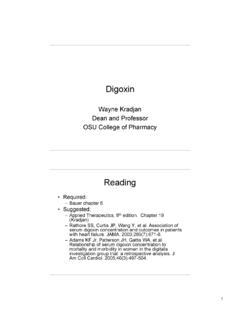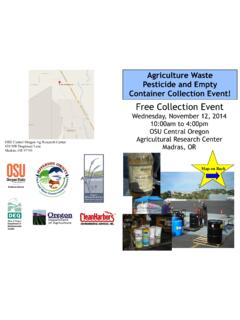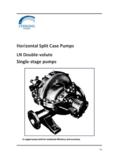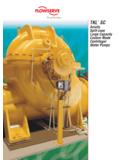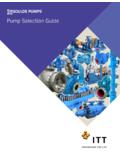Transcription of Chapter 11 Fission - Oregon State University
1 1 Chapter 11 Fission Introduction Fission has a unique importance among nuclear reactions. Apart from the nuclear reactions that drive the sun, no other nuclear reaction has had such a profound impact on the affairs of man. The discovery of Fission , and the developments that proceeded from it, have altered the world forever and have impinged on the consciousness of every literate human being. The exploitation of nuclear energy, which followed the discovery of Fission , particularly in weapons of mass destruction, has been of profound importance to humankind.
2 Chemists have played an important role in the study of Fission . Fission was discovered by the chemists Otto Hahn and Fritz Strassman in 1938 [1]. By painstakingly difficult chemical separations, they were able to show the neutron irradiation of uranium led, not to many new elements as had been thought, but to products like barium, lanthanum, etc. The uranium nucleus had been split! That conclusion caused Hahn and Strassman much concern as they wrote As nuclear chemists working very close to the field of physics, we cannot bring ourselves yet to take such a drastic step (to conclude that uranium had fissioned), which goes against all previous experience in nuclear physics.
3 Nuclear chemists have continued their role in studying Fission , first using chemical techniques and more recently, using physical techniques. Knowledge of Fission and its consequences is important for the nuclear power industry and the related fields of nuclear waste management and environmental cleanup. From the point of view of basic research, Fission is interesting in its own right as a large scale collective motion of the nucleus, as an important exit channel for many nuclear 2 reactions, and as a source of neutron- rich nuclei for nuclear structure studies and use as radioactive beams.
4 The reader should be cautioned that understanding the Fission process represents a very difficult problem. Some of the best minds in chemistry and physics have worked on the problem since the discovery of Fission . Yet while we understand many aspects of the Fission process, there is no overall theoretical framework that gives a satisfactory account of the basic observations. In Figure 11- 1, we show a schematic view of the Fission process. A nucleus with some equilibrium deformation absorbs energy, becoming excited and deforms to a configuration known as the transition State or saddle point configuration.
5 As it deforms, the nuclear Coulomb energy decreases (as the average distance between the nuclear protons increases) while the nuclear surface energy increases (as the nuclear surface area increases). At the saddle point, the rate of change of the Coulomb energy is equal to the rate of change of the nuclear surface energy. The formation and decay of this transition State nucleus is the rate- determining step in the Fission process and corresponds to the passage over an activation energy barrier to the reaction.
6 If the nucleus deforms beyond this point it is irretrievably committed to Fission . When this happens, then in a very short time, the neck between the nascent fragments disappears and the nucleus divides into two fragments at the scission point. At the scission point, one has two highly charged, deformed fragments in contact with each other. The large Coulomb repulsion between the two fragments accelerates them to 90% of their final kinetic energy within 10- 20 s. As these accelerated primary fragments move away from one another, they contract to more spherical shapes, converting their potential energy of deformation into internal 3 excitation energy, , they get hot.
7 This excitation energy is removed by the emission of the prompt neutrons from the fully accelerated fragments and then, in competition with the last neutrons to be emitted, the nucleus emits - rays. Finally, on a longer time scale the neutron- rich fragments emit - - particles. Occasionally one of these - decays populates a high lying excited State of a daughter that is unstable with respect to neutron emission and the resulting emitted neutrons are called the delayed neutrons. Note that this schematic view conflicts with some presentations of Fission in elementary textbooks.
8 For example, if the neutrons are emitted primarily from the fully accelerated fragments, their spatial distribution is along the direction of motion of the fragments. They do not emerge randomly from the nucleus as many artists conceptions of Fission depict. Also note that the energy release in Fission is primarily in the form of the kinetic energies of the fragments not in the neutrons, photons or other emitted particles. This energy is the mass- energy released in Fission due to the increased stability of the Fission fragments.
9 Because of the large amount of information available about Fission , it is beyond the scope of this Chapter to present a complete treatment of Fission research. We shall attempt to emphasize the fundamental aspects of the subject. The reader is referred to one of the excellent monographs or reviews of Fission [3- 6] for further information. The Probability of Fission The Liquid Drop Model Figure 11- 1 suggests Fission proceeds in two steps, the ascent to the saddle point and the passage through the scission point.
10 We shall present our discussion of Fission from this point of view. We shall assert that like chemical reactions, the reaction probability is determined by the passage through the transition State . We shall also assert, more 4 controversially, that the distribution of Fission product energies, masses, etc. is determined at or near the scission point. Let us begin with a discussion of the probability of Fission . For the first approximation to the estimation of the Fission barrier, we shall use the liquid drop model ( Chapter 2).
